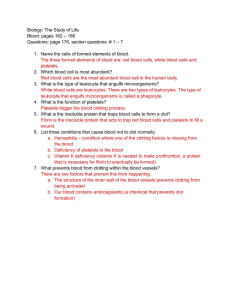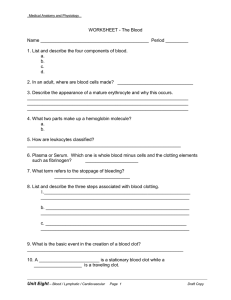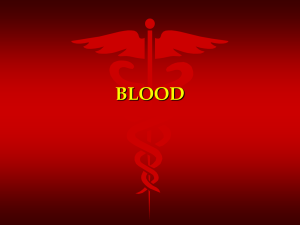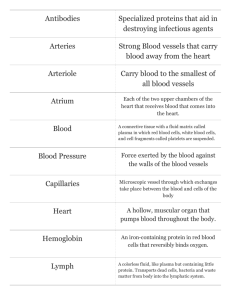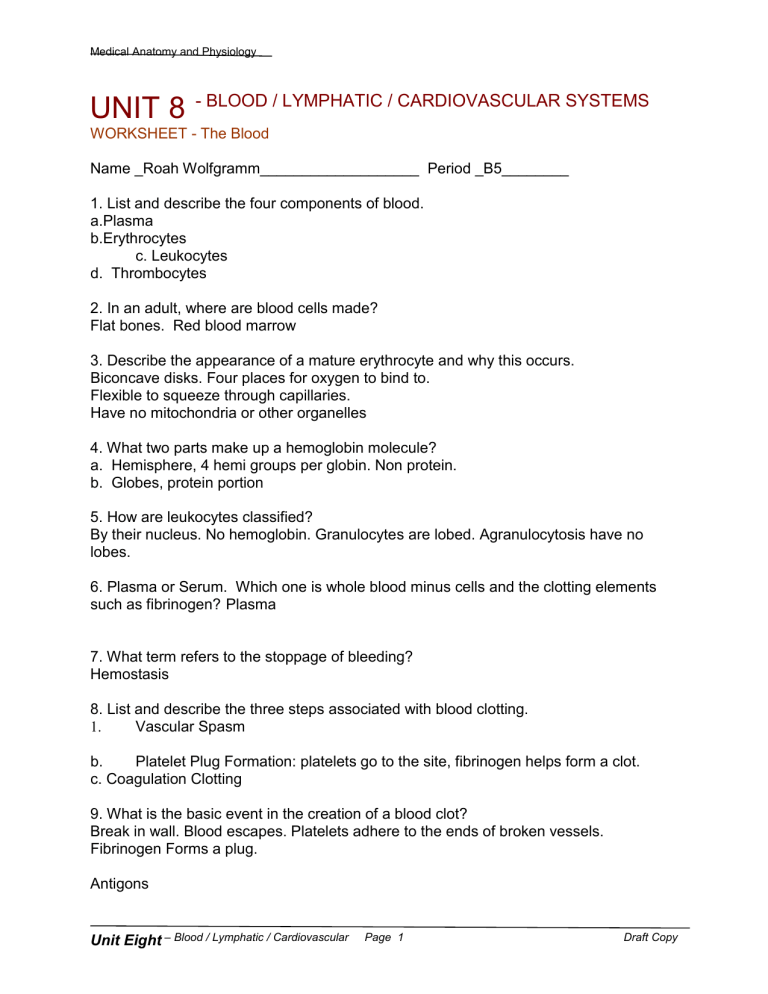
Medical Anatomy and Physiology UNIT 8 - BLOOD / LYMPHATIC / CARDIOVASCULAR SYSTEMS WORKSHEET - The Blood Name _Roah Wolfgramm___________________ Period _B5________ 1. List and describe the four components of blood. a.Plasma b.Erythrocytes c. Leukocytes d. Thrombocytes 2. In an adult, where are blood cells made? Flat bones. Red blood marrow 3. Describe the appearance of a mature erythrocyte and why this occurs. Biconcave disks. Four places for oxygen to bind to. Flexible to squeeze through capillaries. Have no mitochondria or other organelles 4. What two parts make up a hemoglobin molecule? a. Hemisphere, 4 hemi groups per globin. Non protein. b. Globes, protein portion 5. How are leukocytes classified? By their nucleus. No hemoglobin. Granulocytes are lobed. Agranulocytosis have no lobes. 6. Plasma or Serum. Which one is whole blood minus cells and the clotting elements such as fibrinogen? Plasma 7. What term refers to the stoppage of bleeding? Hemostasis 8. List and describe the three steps associated with blood clotting. 1. Vascular Spasm b. Platelet Plug Formation: platelets go to the site, fibrinogen helps form a clot. c. Coagulation Clotting 9. What is the basic event in the creation of a blood clot? Break in wall. Blood escapes. Platelets adhere to the ends of broken vessels. Fibrinogen Forms a plug. Antigons Unit Eight – Blood / Lymphatic / Cardiovascular Page 1 Draft Copy Medical Anatomy and Physiology Agglutinogens Aglutanins A B AB None Anti B Anti A Neither anti A or B Both anti A and B Infection Bleed out easily, no blood clotting By making your body making more red blood cells. Additional Antigone on the surface of their blood. Thrombosis which goes to embolus. Because there are many more antigens than just A, B, or + 10. A Thrombus is a stationary blood clot while a Embolus is a traveling clot. 11. The four blood types in humans are determined by the presence or absence of ______________________________ on the surface of the erythrocytes. _______________________ is another term for antigens and ___________________ is another term for antibodies. 12. Complete the following chart on blood types. Blood Type Antigen Antibody Type A Type B Type AB Type O 13. What might be indicated by an excess of white blood cells in the blood? ________________________________________________________________ 14. What problems might you have if you had no platelets in your blood? 5. As you increase altitude, there is less oxygen in the air. How might this affect your blood? ________________________________________________________________ Unit Eight – Blood / Lymphatic / Cardiovascular Page 2 Draft Copy Medical Anatomy and Physiology ________________________________________________________________ 16. How can blood clotting be bad for you? ________________________________________________________________ 17. What does Rh positive mean? ________________________________________________________________ 18. Type AB blood has often been called the universal recipient meaning a person with this blood type could receive a transfusion of any other blood type. Explain why this phrase is misleading. ________________________________________________________________ ________________________________________________________________ ________________________________________________________________ Unit Eight – Blood / Lymphatic / Cardiovascular Page 3 Draft Copy



